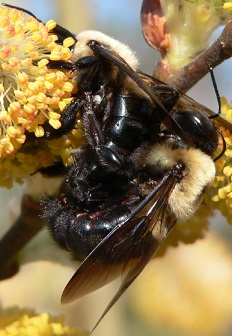Reproduction
Xylocopa virginica emerge from their
nest after overwintering in March, but it is not until April and
into May that they start to reproduce (Gerling and Hermann
1978). This organism will not come out from their nest until the
temperature has warmed to at least 20°C for a week straight
(Skandalis et al. 2011). As they begin to come out for the
mating season, males tend to be seen a few days prior to
females. This is advantageous for males because the first males
that emerge will take on the role of resident male while those
who come out later will become the satellite males (Prager and
Richardson 2012). Establishing these different roles is
important for the reproductive success of the male.
While all males reproduce, or try to
reproduce, X. virginica females take on the role of either a
reproductive or non-reproductive female (Richards 2011). The
reproductive females are considered the dominant female of the
nest who forage for food and care for their young. The
non-reproductive females do not have a role that benefits
 the
nest. They get their food from the reproductive female and
rarely, if ever, leave the nest (Peso and Richards 2010).
the
nest. They get their food from the reproductive female and
rarely, if ever, leave the nest (Peso and Richards 2010).
Eastern Carpenter Bees are unique
in the fact they have multiple mating strategies (Prager and
Richardson 2012). The most common technique is the defense
mating system. This occurs when a resident male X. virginica
guards his territory outside of a nest waiting for a
reproductive female to emerge (Barrows 1983). Once the female
comes out of the nest, the male will immediately grab the
female.
Although
this act of grabbing is often seen as aggressive towards
females, this strategy is overall beneficial to both males and
females. The male bees wait outside of the
nest providing protection to the nest and the potential female
mates (Gerling and Hermann 1978). The second mating
strategy is similar to that of the first, however, instead of
the resident male it is the satellite male that tries to mate
with the female (Barrows 1983). When a resident male leaves his
territory, a satellite male will take on the responsibility of
guarding the nest while he is gone. During this time, if a
female were to come out of her nest, the satellite male would
take advantage of the opportunity and would try to mate with that
female (Prager and Richardson 2012).
Mating between this species also
takes place in areas other than near the nest. Some male X.
virginica will establish territories at food plants and will use
these sites as mating grounds (Barrows 1983). Females are often robbing nectar at plants such as the Rabbiteye Blueberry Plant,
Vaccinium ashei, therefore having
territories away from the nest can be beneficial to male’s
reproductive success (Sampson et al. 2004). Another
similar
strategy is called scramble-competition mating. In this
technique there are no distinct territories created, instead,
male Eastern Carpenter Bees will patrol around various flowers
waiting for a female (Barrows 1983). The last mating strategy
that has been seen in X. virginica takes place near landmarks
that do not already have nests by
them. These landmarks could
include places such as buildings and boulders (Barthell et al.
2006). Although all of these strategies have been observed in
the Eastern Carpenter Bee, most males will first try to gain a
territory near a nest and if unable to do so, will later resort to the other
strategies (Barrows 1983).
robbing nectar at plants such as the Rabbiteye Blueberry Plant,
Vaccinium ashei, therefore having
territories away from the nest can be beneficial to male’s
reproductive success (Sampson et al. 2004). Another
similar
strategy is called scramble-competition mating. In this
technique there are no distinct territories created, instead,
male Eastern Carpenter Bees will patrol around various flowers
waiting for a female (Barrows 1983). The last mating strategy
that has been seen in X. virginica takes place near landmarks
that do not already have nests by
them. These landmarks could
include places such as buildings and boulders (Barthell et al.
2006). Although all of these strategies have been observed in
the Eastern Carpenter Bee, most males will first try to gain a
territory near a nest and if unable to do so, will later resort to the other
strategies (Barrows 1983).
Females begin to lay their eggs in
the beginning of May. Due to the structure of their nest, the
first eggs are
laid at the end of the tunnel which is the furthest point
away from the entrance (Gerling and Hermann 1978). When laying
their eggs, females will place them on a pollen and nectar ball,
which will serve as a source of nourishment to the developing
offspring. Once this is completed, they use the wood they have
chewed while making the tunnels to construct a wall that
separates the offspring from the rest of the nest (North
Carolina Museum of Natural Sciences 2013). This wall will later
be broken by the hatched offspring when they are ready to freely
move about the nest. To learn more about female nesting and the
process of laying their eggs click
here.
Initially, offspring are born with
cloudy white wings that will eventually become brown and then
change to black like that of the adults. Once they have hatched, the
new X. virginica gain the ability to fly within three to four
days. However, it is not until three to four weeks that they will
begin to leave the nest (Gerling and Hermann 1978).
Continue to
Interactions
Return to
Home
Go to
References